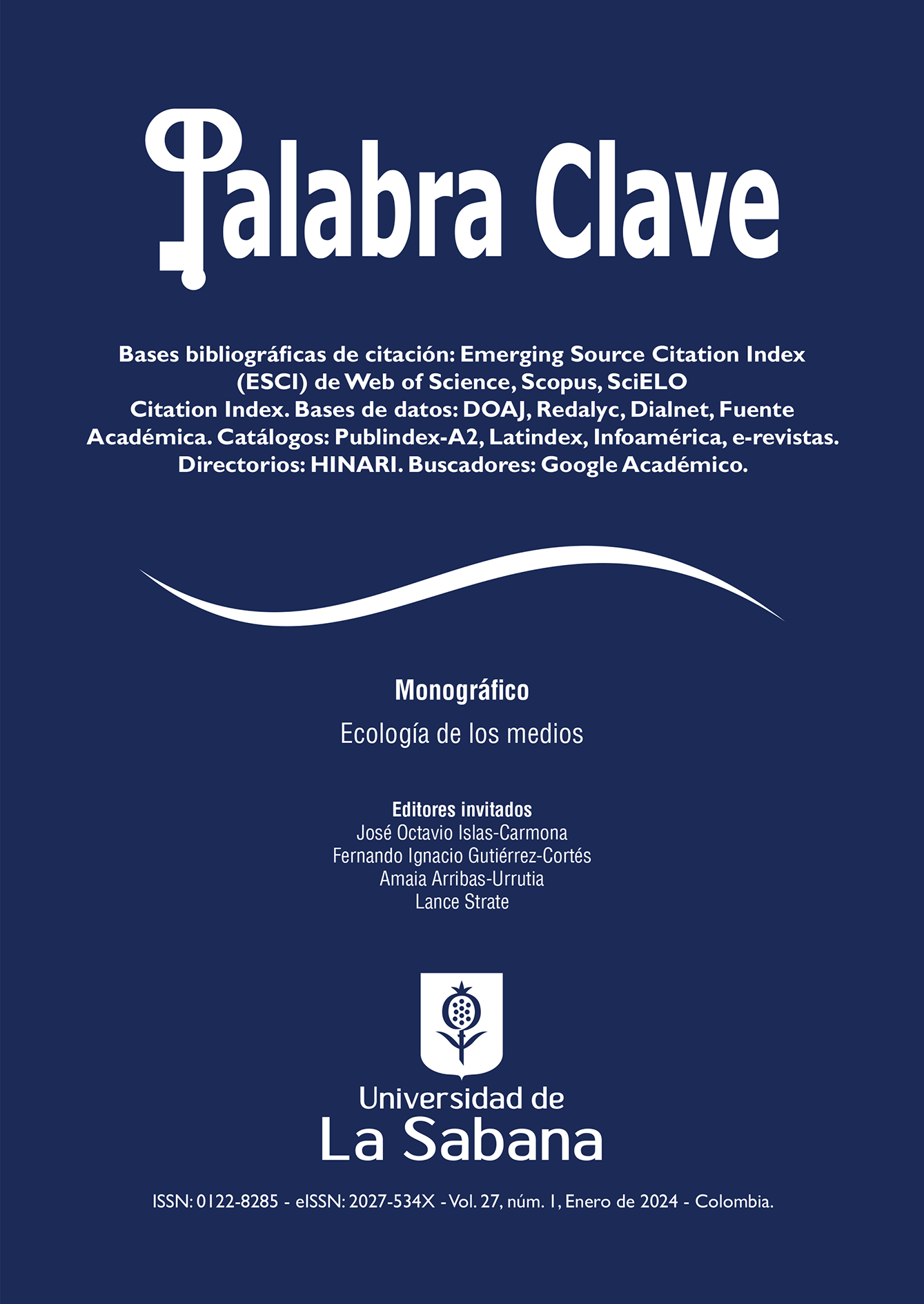Human Creativity vs. Artificial Creativity: Comparative Study between University Students and Chatbots in Idea Generation
DOI:
https://doi.org/10.5294/pacla.2024.27.1.10Keywords:
Creativity, communication, conceptualization, innovation, artificial intelligence, advertisingAbstract
Artificial intelligence (AI) is transforming the creative spaces of society. Some research believes AI can be creative by analyzing and learning from large amounts of data. In contrast, others argue that it generates ideas based on existing patterns, raising questions about its actual creative potential. This study aims to investigate whether AI can be as creative as students of an Advertising and Public Relations undergraduate program specialized in this area. The methodology consisted of a mixed experiment with a verbal creative exercise. Once the students took the test, the poe.com platform was used to evaluate the creativity of the chatbots ChatGPT, Claude-instant, and Dragonfly, following the same instructions given to the students. The conclusions show that AI systems still cannot compete with people’s creative ability. Both quantitative and qualitative results reveal that, although AI can enhance human capabilities, it cannot replace them. Chatbots showed limitations in understanding the subtleties of language, generating new concepts, applying synthesis, and developing lateral thinking. AI can repeat existing patterns but cannot replicate the complexity and richness of human creativity, nor can it make emotional connections to themes.
Downloads
References
Ali Elfa, M. A. y Dawood, M. E. T. (2023). Using artificial intelligence for enhancing human creativity. Journal of Art, Design and Music, 2(2), 3. https://doi.org/10.55554/2785-9649.1017
Aparicio, O. Y. y Ostos, O. L. (2018). El constructivismo y el construccionismo. Riiep, 11(2). https://doi.org/10.15332/s1657-107X.2018.0002.05
Atkinson, D. P. y Barker, D. R. (2023). AI and the social construction of creativity. Convergence, 29(4), 1054-1069. https://doi.org/10.1177/13548565231187730
Boden, M. A. (2017). Inteligencia artificial. Turner.
Bono, E. (2008). Creatividad. 62 ejercicios para desarrollar la mente. Paidós.
Bryndin, E. (2019). Practical development of creative life-saving artificial intelligence. Communications, 7(2), 31-39. https://doi.org/10.11648/j.com.20190702.11
Crimaldi, F. y Leonelli, M. (2023). AI and the creative realm: A short review of current and future applications. arXiv:2306.01795. https://doi.org/10.48550/arXiv.2306.01795
Csikszentmihalyi, M. (1998). Creatividad: el fluir y la psicología del descubrimiento y la invención. Paidós.
Cheng, M. (2022). The creativity of artificial intelligence in art. Proceedings, 81, 110. https://doi.org/10.3390/proceedings2022081110
Das, P. y Varshney, L. R. (2022). Explaining artificial intelligence generation and creativity: Human interpretability for novel ideas and artifacts. IEEE. Signal Processing Magazine, 39(4), 85-95. https://doi.org/10.1109/MSP.2022.3141365
De-Vicente-Yagüe-Jara, M. I., López-Martínez, O., Navarro-Navarro, V. y Cuéllar-Santiago, F. (2023). Escritura, creatividad e inteligencia artificial. ChatGPT en el contexto universitario. Comunicar. Revista Científica de Comunicación y Educación, 31(77). https://doi.org/10.3916/C77-2023-04
DiPaola, S., Gabora, L. y McCaig, G. (2018). Informing artificial intelligence generative techniques using cognitive theories of human creativity. Procedia Computer Science, 145, 158-168. https://doi.org/10.1016/j.procs.2018.11.024
Erden, Y. J. (2010). Could a created being ever be creative? Some philosophical remarks on creativity and AI development. Minds and Machines, 20, 349-362. https://doi.org/10.1007/s11023-010-9202-2
Esling, P. y Devis, N. (2020). Creativity in the era of artificial intelligence. arXiv preprint arXiv:2008.05959.
Esquivias Serrano, M. T. (2004). Creatividad: definiciones, antecedentes. Revista Digital Universitaria, 5(1).
Fajardo, Z. I. E., Gamboa, M. A. C., Valdivieso, M. V. H. y Murillo, J. P. M. (2024). Cómo impacta la inteligencia artificial en la educación. Reciamuc, 8(1), 62-70. https://doi.org/10.26820/reciamuc/8.(1).ene.2024.62-70
Flores-Vivar, J. M. y García-Peñalvo, F. J. (2023). Reflexiones sobre la ética, potencialidades y retos de la inteligencia artificial en el marco de la educación de calidad (ODS4). Comunicar, 74, 37-47. https://doi.org/10.3916/C74-2023-03
Gobet, F. y Sala, G. (2019). How artificial intelligence can help us understand human creativity. Frontiers in Psychology, 10, 1401. https://doi.org/10.3389/fpsyg.2019.01401
Herrán, A. (2008). Creatividad para la formación. En J. Sánchez Huete eds., Compendio de didáctica general (pp. 557-606). CCS.
Jennings, K. E. (2010). Developing creativity: Artificial barriers in artificial intelligence. Minds and Machines, 20, 489-501. https://doi.org/10.1007/s11023-010-9206-y
Kirkpatrick, K. (2023). Can AI demonstrate creativity? Communications of the ACM, 66(2), 21-23. https://doi.org/10.1145/3575665
Kurt, D. (2018). Artistic creativity in artificial intelligence. [Tesis, Master of Arts, Department of Creative Industries, University Nijmegen, Países Bajos].
López de Mántaras Badía, R. y Meseger González, P. (2017). Inteligencia artificial. Catarata.
Martínez, L. D. C. (2019). La creatividad y la educación en el siglo XXI. Revista Interamericana de Investigación, Educación y Pedagogía, 12(2), 211-224. https://doi.org/10.15332/25005421.5014
Muñoz, M. A. G. (2021). El impacto de la inteligencia artificial en la sociedad y su aplicación en el sector financiero. Revista Diecisiete, 4, 167-174. https://doi.org/10.36852/2695-4427_2021_04.15
Pascualetto, G. (2004). Creatividad en la educación universitaria. Hacia la concepción de nuevos posibles. Cuadernos del Centro de Estudios en Diseño y Comunicación. Ensayos, 16, 67-76.
Reddy, A. (2022). Artificial everyday creativity: Creative leaps with AI through critical making. Digital Creativity, 1-19. https://doi.org/10.1080/14626268.2022.2138452
Romo, M. (1997). Psicología de la creatividad. Paidós.
Sesé, J. R. (2019). La inteligencia artificial y la creatividad. Civae, 1, 68.
Torrance, P. (1998). Educación y capacidad creativa. Morova.
Unesco (2019). International conference on Artificial intelligence and Education. Planning education in the AI Era: Lead the leap: Final report.
Villasmil, J. (2021). Implicaciones de la inteligencia artificial para la humanidad. Revista de la Universidad del Zulia, 32, 4-6. https://doi.org/10.46925//rdluz.32.01
Published
How to Cite
Issue
Section
License
Copyright (c) 2024 Julinda Molares-Cardoso, Vicente Badenes-Plá, Carmen Maiz-Bar

This work is licensed under a Creative Commons Attribution 4.0 International License.
1. Proposed Policy for Journals That Offer Open Access
Authors who publish with this journal agree to the following terms:
- Authors retain copyright and grant the journal right of first publication with the work simultaneously licensed under a Creative Commons Attribution License that allows others to share the work with an acknowledgement of the work's authorship and initial publication in this journal.









